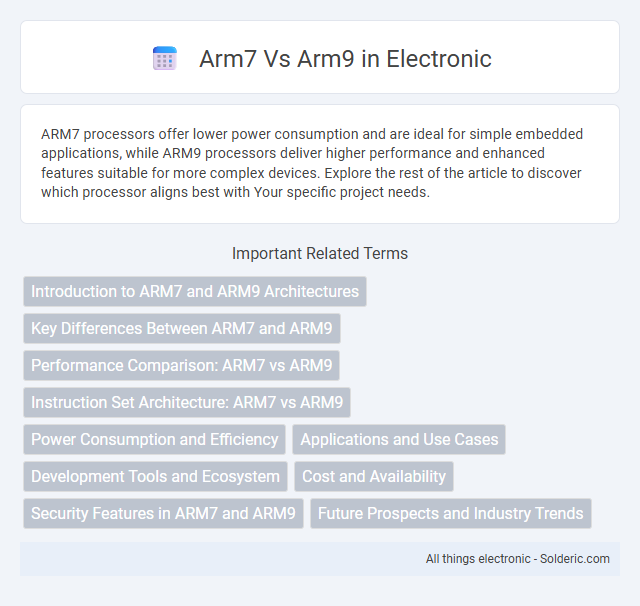ARM7 processors offer lower power consumption and are ideal for simple embedded applications, while ARM9 processors deliver higher performance and enhanced features suitable for more complex devices. Explore the rest of the article to discover which processor aligns best with Your specific project needs.
Comparison Table
| Feature | ARM7 | ARM9 |
|---|---|---|
| Architecture | ARMv4T | ARMv5TE |
| Pipeline Stages | 3-stage pipeline | 5-stage pipeline |
| Clock Speed | Up to 60 MHz | Up to 200+ MHz |
| Performance | Lower MIPS | Higher MIPS, enhanced DSP |
| Cache | No cache | Separate I-cache and D-cache |
| Instruction Set | ARM & Thumb | ARM, Thumb & DSP extensions |
| Applications | Embedded systems, low power devices | Mobile devices, higher performance embedded |
| Power Consumption | Low | Moderate, optimized power management |
Introduction to ARM7 and ARM9 Architectures
ARM7 and ARM9 architectures represent two significant generations in ARM's processor development, with ARM7 based on the ARMv4T architecture and ARM9 on the ARMv5TE architecture. ARM9 introduces enhancements such as improved pipeline design and better cache management, leading to higher performance and efficiency compared to ARM7. Your choice between ARM7 and ARM9 impacts system capabilities, power consumption, and suitability for real-time applications.
Key Differences Between ARM7 and ARM9
ARM7 features a 32-bit RISC architecture with a single pipeline and typically operates at clock speeds up to 60 MHz, whereas ARM9 incorporates a 5-stage pipeline enabling higher clock speeds up to 200+ MHz and improved instruction throughput. ARM9 supports Harvard architecture with separate instruction and data caches, offering enhanced performance and reduced latency compared to the ARM7's von Neumann architecture. The ARM9 core introduces DSP instructions and improved power management capabilities, making it more suitable for multimedia and communication applications.
Performance Comparison: ARM7 vs ARM9
ARM9 processors deliver significantly higher performance than ARM7 cores due to their advanced pipeline architectures, typically featuring 5- to 9-stage pipelines compared to the 3-stage pipeline of ARM7. This increased pipeline depth allows ARM9 to achieve higher clock speeds and better instruction throughput, making it suitable for more demanding applications. Your choice between ARM7 and ARM9 impacts system efficiency, with ARM9 providing improved processing power and enhanced capabilities for multimedia and real-time processing.
Instruction Set Architecture: ARM7 vs ARM9
ARM7 utilizes the ARMv4T architecture, supporting a 32-bit ARM instruction set alongside a 16-bit Thumb instruction set for improved code density. ARM9, based on the ARMv5TE architecture, introduces enhanced instruction capabilities with DSP extensions and a more efficient pipeline, enabling faster execution and better performance. Your choice between ARM7 and ARM9 impacts the available instruction set features and overall processing efficiency for embedded applications.
Power Consumption and Efficiency
The ARM7 architecture typically consumes less power due to its simpler pipeline and lower clock speeds, making it ideal for low-power embedded applications. ARM9, while more power-hungry because of enhanced performance features like a deeper pipeline and higher clock frequencies, offers better efficiency by performing tasks faster and reducing active processing time. Optimizing power consumption in ARM9 systems often involves dynamic voltage scaling and clock gating to balance performance needs with energy efficiency.
Applications and Use Cases
ARM7 processors are commonly used in low-power embedded systems, such as simple microcontrollers, handheld devices, and basic consumer electronics, where cost efficiency and power consumption are critical. ARM9 processors offer improved performance and enhanced processing capabilities, making them suitable for more demanding applications like smartphones, digital cameras, and automotive systems requiring real-time data processing. Your choice between ARM7 and ARM9 will depend on the specific application's performance requirements and power constraints.
Development Tools and Ecosystem
ARM7 and ARM9 processors boast distinct development tools and ecosystems, with ARM9 benefiting from advanced Integrated Development Environments (IDEs) such as Keil MDK-ARM and ARM DS-5, offering enhanced debugging and optimization features. The ARM9 ecosystem provides robust middleware support, including real-time operating systems (RTOS) like FreeRTOS and embedded Linux, facilitating complex application development. ARM7, while supported by mature toolchains, lacks certain modern features and optimizations present in ARM9, impacting development efficiency and software scalability.
Cost and Availability
ARM7 processors generally offer lower cost and wider availability due to their longer presence in the market and simpler architecture, making them suitable for cost-sensitive and legacy applications. ARM9 cores provide enhanced performance and features but come at a higher cost and may have more limited availability compared to ARM7, targeting mid-range embedded systems. Manufacturers and developers often choose ARM7 for budget constraints and mass production, while ARM9 is preferred for applications requiring better processing power despite increased expenses.
Security Features in ARM7 and ARM9
ARM9 processors offer enhanced security features over ARM7, including TrustZone technology that provides hardware-enforced security partitions, enabling secure execution of sensitive code. ARM7 cores lack these advanced security extensions, making them more suitable for less critical applications where basic protection suffices. Your choice between ARM7 and ARM9 should consider the level of security required, with ARM9 better suited for applications demanding robust, hardware-backed security measures.
Future Prospects and Industry Trends
ARM9 processors offer enhanced performance and power efficiency compared to ARM7, making them more suitable for future applications in mobile and embedded systems. Industry trends indicate a growing shift towards ARM9 and newer architectures due to their improved support for multimedia, security features, and real-time processing capabilities. Your choice between ARM7 and ARM9 should consider long-term software support and compatibility with emerging IoT and AI technologies.
arm7 vs arm9 Infographic

 solderic.com
solderic.com